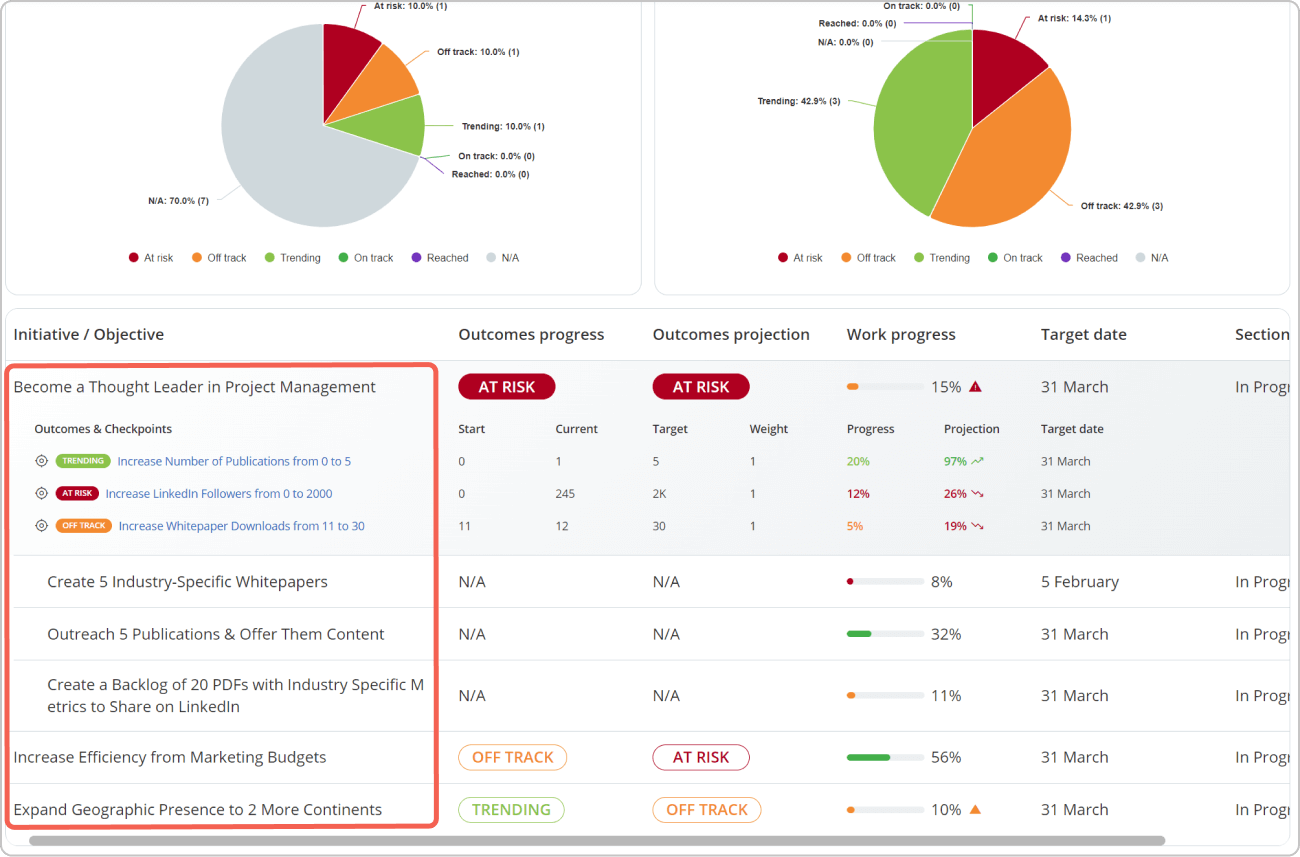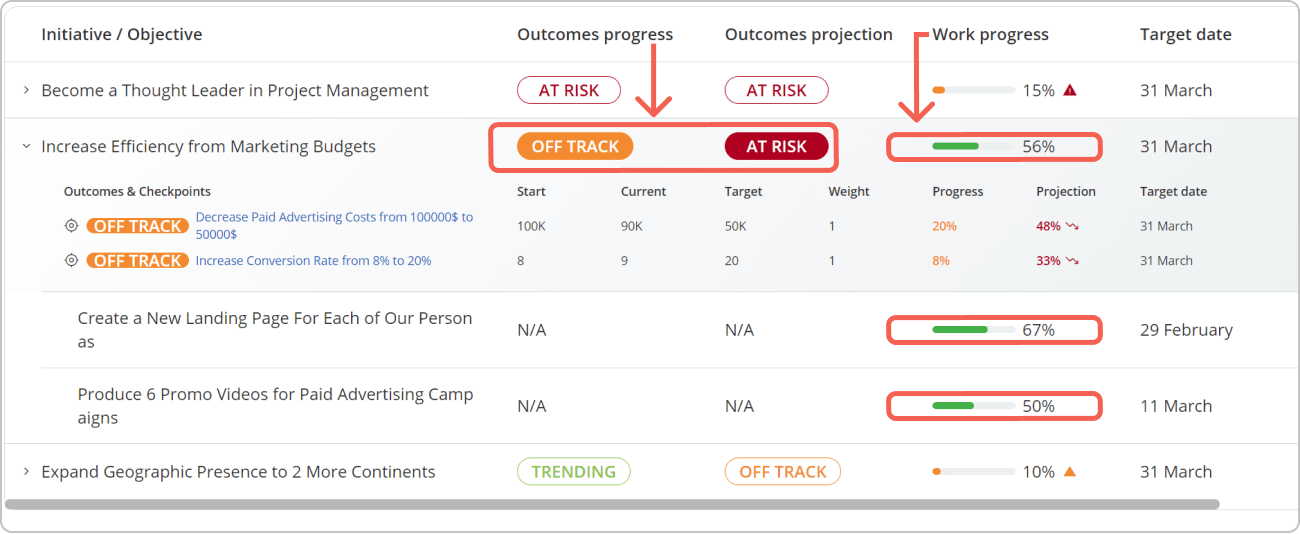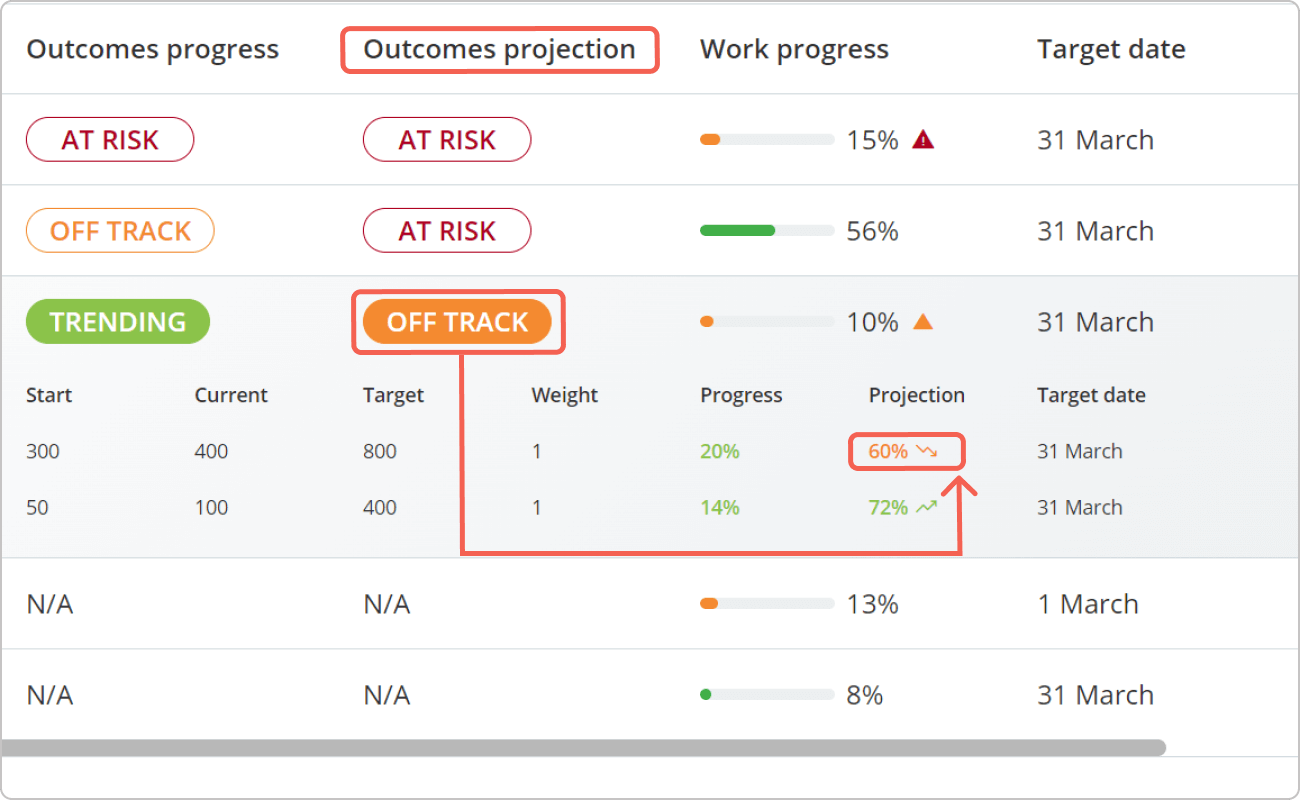We’re in the era of digital transformation and AI, where traditional management is fading into the past. As today’s market environment is more dynamic than ever, it’s not viable anymore to focus only on work without understanding its business impact.
Enter outcome-based management. This approach shifts the focus to measuring the tangible results of your efforts. It’s about understanding whether your outputs directly influence the desired outcomes. In simpler terms, are the results of your work driving the success you aim to achieve?
At Businessmap, we address this question by using a management hub that consolidates comprehensive information about our outcomes and work activities into a central platform – the Initiatives and Outcomes dashboard.
Initiatives and Outcomes Management Dashboard: Quick Overview
For those who might not be familiar with Businessmap, every work initiative lives within boards and workspaces. Within those work initiatives, you can create outcomes and enable OKRs. To do that, remember that the work initiative could be your Objective, while the outcomes serve as Key Results.
![]()
The Initiatives and Outcomes dashboard then acts as a central management hub, pulling data from selected boards. Its goal is to give you an overview of the status of both outcomes (key results) and work initiatives (objectives) so you can make data-driven decisions.
The dashboard is a great resource for implementing OKRs because you can directly compare the outcomes vs work progress. However, in the early stages of their OKR implementation, a lot of our customers wonder how they can interpret the data from the dashboard and, most importantly, what they should do with it.
So, we’ve decided to go over a few common use cases below. Before you move forward, we strongly encourage you to first learn how to work with the dashboard.
Three Use Cases for Outcome-Based Project Management
Keep in mind that the tips below are subjective, and they could mean different things in your environment.
Let’s get started.
Use Case 1: Both My Outcomes Progress and Work Progress Are at Risk/Off Track
A basic scenario is when the status of your outcomes and work initiatives are both falling behind schedule. For example, imagine that you want to become a thought leader in project management, which is your top-level initiative and objective. To measure your progress, you’ve created several outcomes (key results) and child work initiatives/projects.

In the Initiatives and Outcomes dashboard, you can see that the Outcomes progress of the entire objective is At Risk, which happens because one of its corresponding key results is At Risk, too.

On the other hand, the work progress of the objective is Off Track due to a deviation above 15% from its expected progress.
Looking at the work progress of the lower-level projects, you can see that "Create 5 Industry-Specific Whitepapers" is only 8% done, while the target date is the 5th of February.

What Does It Mean and What Possible Actions Can You Take?
Having both the outcomes and work progress At Risk/Off Track is a signal that you’ve not been getting enough work done to yield positive results. Our advice would be to dig into the teams responsible for the projects with low work progress that are part of the main initiative/objective.
Perhaps there is something blocking their work, or they lack enough capacity. A possible solution would be to temporarily allocate more capacity to the project with the lowest work progress and closest target date.
Use Case 2: My Outcomes Progress Is At Risk/Off Track, but the Work Progress Is On Track/Trending
One of the most common scenarios is to have a large chunk of the output ready without seeing significant results from your efforts. This leaves a lot of managers wondering if they’re doing the right things.
In our example, let’s imagine that an important objective for the Marketing department is to spend their budgets more efficiently. To achieve this, they want to decrease paid advertising costs while increasing conversion rates from existing campaigns.

As you can see from the Initiatives and Outcomes dashboard, the work progress of the main Objective stands at 56%, and its child projects are also moving very well. However, the outcomes are Off Track, and they’re projected to miss the target result by a large margin until the deadline is reached.

What Does It Mean and What Possible Actions Can You Take?
Before rushing to conclude that you’ve been working on the wrong things, let’s illustrate what we’ve seen from our experience.
First, in the example above, it’s possible that it takes time to see results from the work you’ve done so far. This could mean that you need to extend your target date or that you’ve created outcomes/key results that are too ambitious.
Take the "Create a New Landing Page for Each of Our Personas" project.

It’s reasonable to have to wait for some time until you see the results of your efforts. In this case, our advice would be to temporarily park the project in a queue stage. You can do this by creating an "Experiments" stage on your board where you can track the results. To lower the risk of wasted work, we advise you to take this action before the entire project is complete as a way of proving whether you’re moving in the right direction.
Another possibility here is that you may need to add more scope to the projects. Think of it as generating new ideas.
Perhaps the direction is right, but you need to take a slightly different approach to start seeing the intended results. In this scenario, we advise you to hold an OKRs review during some of your weekly meetings and gather your team’s opinion on the matter.
Use Case 3: My Outcomes Progress Is On Track/Trending with Minimal Efforts
Sometimes, you can have satisfying results when only a small portion of the work is done.
For example, looking at the Initiatives and Outcomes management dashboard, the "Expand Geographic Presence to 2 More Continents" has a Trending OKR status while only 10% of the work is done, and you’re behind schedule.

It’s evident from the dashboard that one of the corresponding child projects for the main objective is also behind schedule.

What Does It Mean and What Possible Actions Can You Take?
This usually means that some initial efforts contributed to those positive outcomes. It’s also possible that you didn’t set ambitious enough goals, but based on your target date for achieving the outcomes/key results, it could be too early to tell for sure.
If that occurs in your environment, revisit your work initiatives together with your team and discuss whether you should create new targets for your outcomes/key results. Logically, the more output you produce, the better results you’re expected to get.
However, we strongly advise you to keep an eye on the "Outcomes projection" column. If it’s At Risk or Off Track, it means eventually, you will be in danger of falling behind your OKR status. So, keep that as a sign to not let your foot off the gas and focus on producing more output to ensure you reach your goals.

Leveraging Outcomes Management for Data-Driven Success
These are just a few examples from our experience, but we hope they help you manage your outcomes more effectively using data-driven insights. The key takeaway is to always delve deeper into your work and understand how it brings you closer to your goals.
At the end of the day, delivering work faster is only a fraction of what business agility is about. Instead, the greater benefit comes from accelerating your decision-making, so you can seize opportunities quicker and gain a competitive advantage by doing the right things at the right time.
Businessmap is the most flexible software, helping your company gain visibility across all projects/portfolios, align on goals, and deliver quality work faster.

Nikolay Tsonev
Product Marketing | PMI Agile | SAFe Agilist certified
Nick is a seasoned product marketer and subject matter expert at Businessmap, specializing in OKRs, strategy execution, and Lean management. Passionate about continuous improvement, he has authored numerous resources on modern-day management. As a certified PMI practitioner and SAFe Agilist, Nick frequently shares his insights at Lean/Agile conferences and management forums.



